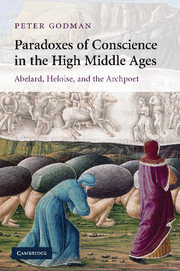Book contents
- Frontmatter
- Contents
- Preface and acknowledgements
- List of abbreviations
- 1 Moral moments
- 2 The neurotic and the penitent
- 3 True, false, and feigned penance
- 4 Fame without conscience
- 5 Cain and conscience
- 6 Feminine paradoxes
- 7 Sincere hypocrisy
- 8 The poetical conscience
- Envoi: Spiritual sophistry
- Bibliography
- Index of quotations
- General index
- CAMBRIDGE STUDIES IN MEDIEVAL LITERATURE
- Frontmatter
- Contents
- Preface and acknowledgements
- List of abbreviations
- 1 Moral moments
- 2 The neurotic and the penitent
- 3 True, false, and feigned penance
- 4 Fame without conscience
- 5 Cain and conscience
- 6 Feminine paradoxes
- 7 Sincere hypocrisy
- 8 The poetical conscience
- Envoi: Spiritual sophistry
- Bibliography
- Index of quotations
- General index
- CAMBRIDGE STUDIES IN MEDIEVAL LITERATURE
Summary
‘Now and then it is possible to observe the moral life in process of revising itself, perhaps by reducing the emphasis it formerly placed upon one or another of its elements, perhaps by inventing and adding to itself a new element, some mode of conduct or of feeling which hitherto it had not regarded as essential to virtue.’ Three such moments occurred between the second and the third quarters of the twelfth century. Each of them marked the emergence of a paradox of conscience unknown, or at least unrecorded, for more than half a millennium. Revived and refashioned in Latin, the ancient language of high culture, none of these paradoxes was tinged with the nostalgia of classicism. Expressions of a moral sensibility in the re-making, they served as barometers of change.
The change to which paradox pointed was both spiritual and intellectual. Accurately described as the reformation of the twelfth century, its motive force was monastic. The attempt to re-establish, in its original strictness, the Rule of St Benedict; the efforts to restore the pristine purity of liturgical worship and prayer; the measurement of authentica et proba by the standards of an exemplary past: these and other signs of concern with the genuine article were not accompanied by a decline in the production of forgeries. Naturally enough. Compliments paid to others by admirers striving to surpass themselves, fakes represent the other side of authenticity's coin. That side has more than one facet.
- Type
- Chapter
- Information
- Paradoxes of Conscience in the High Middle AgesAbelard, Heloise and the Archpoet, pp. 1 - 18Publisher: Cambridge University PressPrint publication year: 2009

